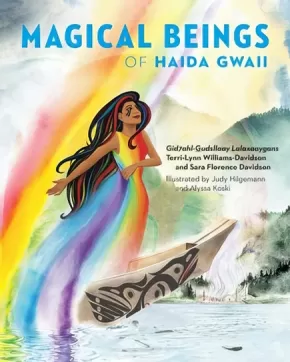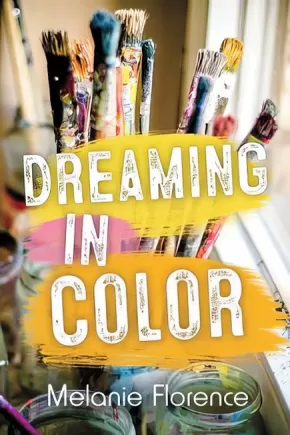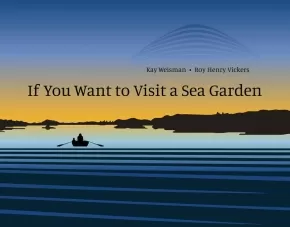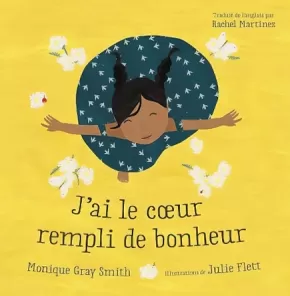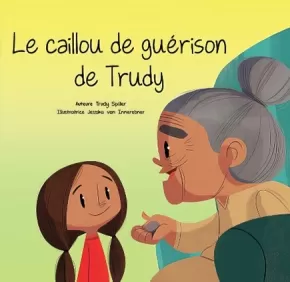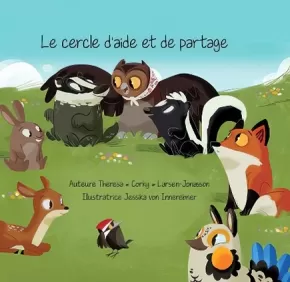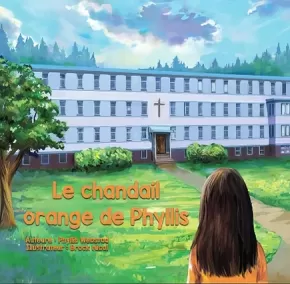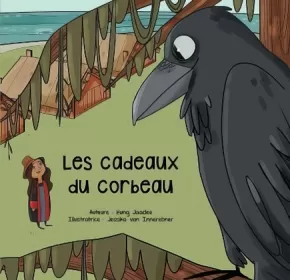
Canadian Indigenous Books for Schools K-7 2020-2021
1
-
15
of
51 Results;
Sort By
Go To
of 4
This list of Indigenous titles was published by The Association of Book Publishers of British Columbia (ABPBC) in 2020-2021.
How I Survived: Four Nights on the Ice (PB)
$18.95
Artists:
Format:
Paperback
Text Content Territories:
Indigenous Canadian; Inuit;
ISBN / Barcode: 9781772274264
Synopsis:
Synopsis:
After his snowmobile breaks down halfway across the sea ice on a trip back from a fishing camp, Serapio Ittusardjuat recounts the traditional skills and knowledge he leaned on to stay alive.
This harrowing first-person account of four nights spent on the open sea ice—with few supplies and no water—shows young readers the determination and strength necessary to survive in the harsh Arctic climate, even when the worst occurs.
Awards
- 2022 Forest of Reading—Silver Birch Express Award
Reviews
"[T]he graphic novel How I Survived is a true story of Arctic survival written by Serapio Ittusardjuat, an Inuk stone carver and former mechanic.... This beautifully designed, highly engaging graphic novel should engross both reluctant readers and those seeking adventure." - Quill & Quire
Educator Information
Recommended for ages 12+
The original hardcover version was included in the Indigenous Books for Schools 2020/2021 resource list as being useful for grades 6 to 9 for English Language Arts and Social Studies.
Additional Information
48 pages | 7.25" x 9.75"
I Lost My Talk (PB)
$13.95
Artists:
Format:
Paperback
Text Content Territories:
Indigenous Canadian; First Nations; Mi'kmaq;
ISBN / Barcode: 9781774710050
Synopsis:
Synopsis:
I lost my talk
The talk you took away
When I was a little girl
At Shubenacadie school.
One of Rita Joe's most influential poems, "I Lost My Talk" tells the revered Mi'kmaw Elder's childhood story of losing her language while a resident of the residential school in Shubenacadie, Nova Scotia. An often quoted piece in this era of truth and reconciliation, Joe's powerful words explore and celebrate the survival of Mi'kmaw culture and language despite its attempted eradication.
A companion book to the simultaneously published I'm Finding My Talk by Rebecca Thomas, I Lost My Talk is a necessary reminder of a dark chapter in Canada's history, a powerful reading experience, and an effective teaching tool for young readers of all cultures and backgrounds. Includes a biography of Rita Joe and striking colour illustrations by Mi'kmaw artist Pauline Young.
Reviews
"This picture book version of I Lost My Talk is best read with Rebecca Thomas’s I’m Finding My Talk. These haunting, evocative books bring an original approach to the exploration of Canadian residential schools in picture books. For readers and teachers who appreciate fact-based information, there is also “A Short History of Residential Schools” at the end of I Lost My Talk. Educators, librarians, and families will find their classrooms and book collections invaluably enriched by these books. They are real tools of truth and reconciliation; as such, they belong on every bookshelf in Canada and beyond." - CM Reviews
Educator Information
Recommended for ages 4 to 9.
This work features a short history of residential schools and information about the author.
Recommended in the Canadian Indigenous Books for Schools 2020/2021 resource list for grades 1-7 for English Language Arts.
Additional Information
32 pages | 8.00" x 10.00"
I'm Finding My Talk (PB)
$13.95
Artists:
Format:
Paperback
Text Content Territories:
Indigenous Canadian; First Nations; Mi'kmaq;
ISBN / Barcode: 9781774710067
Synopsis:
Synopsis:
I'm finding my talk
And it may take some time,
But I'm learning to speak
In a language that's mine.
A response to Rita Joe's iconic poem "I Lost My Talk," and published simultaneously with the new children's book edition illustrated by Pauline Young, comes a companion picture book by award-winning spoken-word artist and Mi'kmaw activist Rebecca Thomas. A second-generation residential school survivor, Thomas writes this response poem openly and honestly, reflecting on the process of working through the destructive effects of colonialism.
From sewing regalia to dancing at powow to learning traditional language, I'm Finding My Talk is about rediscovering her community, and finding culture. Features stunning, vibrant illustrations by Mi'kmaw artist Pauline Young.
Reviews
"Published as a companion to the picture book I Lost My Talk, featuring the famous poem by Rita Joe, both volumes explore the legacy of Canada’s residential schools. They feature vibrant illustrations by Pauline Young that bring the words alive with emotional nuance. This remarkable pair of books possesses the rare ability of being suited to readers of all ages: three to six-year-olds, the traditional intended audience of picture books, will be captivated by the bright, lively illustrations; elementary and middle school children will find their Social Studies curriculum enriched by experiencing these important concepts rendered creatively; teens and adults will gain insight and empathy by enjoying these beautiful poems." - CM Reviews
"[A]n honest reflection on the process of working through the destructive effects of colonialism by participating in cultural connections. This book offers the opportunity to show the journey one takes when rediscovering their community and culture." - The Dalai Lama Center
Educator Information
Recommended for ages 4 to 9.
Recommended in the Canadian Indigenous Books for Schools 2020/2021 resource list for grades 1-3 in the areas of Social Studies and Language Arts.
Former Halifax Poet Laureate and second-generation residential school survivor Rebecca Thomas writes honestly and powerfully in this companion piece to Rita Joe's I Lost My Talk. Includes vibrant illustrations from Mi'kmaw artist Pauline Young.
Additional Information
32 pages | 8.00" x 10.00"
Magical Beings of Haida Gwaii (PB)
$14.95
Format:
Paperback
Text Content Territories:
Indigenous Canadian; First Nations; Haida;
ISBN / Barcode: 9781772033700
Synopsis:
Synopsis:
Based on ancient Haida narratives, this vibrantly illustrated children's book empowers young people and teaches them to live in harmony with nature.
Haida Gwaii is home to a rich and vibrant culture whose origins date back thousands of years. Today, the Haida People are known throughout Canada and the world for their artistic achievements, their commitment to social justice and environmental protection, and their deep connection to the natural world. Embedded in Haida culture and drawn from ancient oral narratives are a number of Supernatural Beings, many of them female, who embody these connections to the land, the sea, and the sky. Magical Beings of Haida Gwaii features ten of these ancient figures and presents them to children as visually engaging, empowering, and meaningful examples of living in balance with nature. Developed by renowned Haida activist, lawyer, performer, and artist Terri-Lynn Williams-Davidson and Haida educator Sara Florence Davidson, this book challenges stereotypes, helps advance reconciliation, and celebrates Indigenous identity and culture.
Reviews
"Magical Beings of Haida Gwaii is a gentle, powerful collection of words and pictures, stories that hold knowledge, teachings, and traditions for the generations of today and the future. A must-read for those who live on the beautiful island of Haida Gwaii, and any Canadian who wants to learn about one of the many vital Indigenous cultures across Turtle Island." — David A. Robertson, winner of the Governor General’s award for When We Were Alone
"Magical Beings of Haida Gwaii is an enchanting book born of a close relationship and understanding of how we see the world from an Indigenous perspective. There is an intrinsic value to stories recorded from the most natural of primary sources, our families. Terri-Lynn and Sara Davidson have given us a lesson on how to value our Indigenous magical beings as we all have them."— Naa-Jing-Jada, Verna J. Kirkness, educator and author of Creating Space: My Life and Work in Indigenous Education
"An absolute treasure and honouring for the Haida People and for Haida Gwaii, and a marvel of devotion for the world to learn from. Oh I love this book so much! I am in awe of Magical Beings of Haida Gwaii. Every Nation deserves a book as gorgeous and as healing as this one." — Richard Van Camp, award-winning author of Moccasin Square Gardens
Educator Information
Recommended for ages 5 to 8.
Recommended in the Canadian Indigenous Books for Schools 2020/2021 resource list for grades 2 to 9 for English Language Arts, Fine Arts, and Social Studies.
Includes a glossary and pronunciation guide at the back.
A Colouring and Activity Book for this work can be found here: Magical Beings of Haida Gwaii Colouring and Activity Book
Additional Information
64 pages | 8.00" x 10.00" | Paperback
Dreaming in Color
$10.95
Format:
Paperback
Text Content Territories:
Indigenous Canadian;
ISBN / Barcode: 9781459825864
Synopsis:
Synopsis:
Jennifer McCaffrey has been working hard on her art for years and is thrilled when she is accepted to a prestigious art school. The school is everything she always thought it would be, mostly. There is one group of kids who seem to resent her and say she only got in because of her skin color. Jen, who loves to create new pieces of artwork that incorporate her Indigenous heritage, finds herself a target when the group tells her to stop being “so Indian”. The night before the big art show at school, Jen’s beading art project is defaced. Jen has to find a way not to let the haters win.
Reviews
“Offers a mirror to the sometimes painful emotions and everyday experiences of Indigenous teens of mixed heritage. A rare and welcome reluctant reader title featuring an Indigenous protagonist.” — Kirkus Reviews
“Through the novel’s accessible language and short chapters, readers of all levels and backgrounds will be able to relate to and learn from Jen’s overcoming racial prejudice and intolerance. Readers will also gain a sense of empathy as they come to understand the struggles faced by Indigenous youth in contemporary society. Highly Recommended.” — CM: Canadian Review of Materials
Educator & Series Information
Recommended for ages 12+
Fry Reading Level: 3.4
Themes: racism, prejudice, standing up to bullies, cultural pride, Indigenous art
Dreaming in Color is a companion novel to the bestselling He Who Dreams (the main character is John's sister).
New, enhanced features (dyslexia-friendly font, cream paper, larger trim size) to increase reading accessibility for dyslexic and other striving readers.
Recommended in the Canadian Indigenous Books for Schools 2020/2021 resource list for grades 6 to 9 for English Language Arts.
This is an Orca Soundings book. Orca Soundings are short, high-interest novels written specifically for teens. These edgy stories with compelling characters and gripping storylines are ones they will want to read.
Additional Information
144 pages | 5.00" x 7.50"
If You Want to Visit a Sea Garden
$18.99
Format:
Hardcover
Text Content Territories:
Indigenous Canadian;
ISBN / Barcode: 9781554989706
Synopsis:
Synopsis:
Discover the wonder of ancient sea gardens on the Northwest Coast
Sea gardens have been created by First Peoples on the Northwest coast for more than three thousand years. These gardens consist of stone reefs that are constructed at the lowest tide line, encouraging the growth of clams and other marine life on the gently sloped beach.
This lyrical story follows a young child and an older family member who set out to visit a sea garden early one morning, as the lowest tides often occur at dawn. After anchoring their boat, they explore the beach, discover the many sea creatures that live there, hear the sputtering of clams and look closely at the reef. They reflect on the people who built the wall long ago, as well as those who have maintained it over the years. After digging for clams, they tidy up the beach, then return home.
An author’s note provides further information about sea gardens (also known as clam gardens), which yield a reliable food source and have been traditional places of learning. They have been found along the Pacific coast, from Alaska to British Columbia to Washington State, and some of these gardens are being restored today.
The manuscript has been vetted and approved by the scientists of the Clam Garden Network and Kwaxsistalla Wathl’thla Clan Chief Adam Dick. Roy Henry Vickers, whose ancestry includes the Tsimshian, Haida and Heiltsuk First Nations, has created hauntingly beautiful images to accompany the text.
Reviews
“The text and illustrations combine grace and knowledge, offering a stunning nonfiction picture book that celebrates First Nations cultural traditions.” — School Library Journal
“This engaging tale is a natural for lessons about ecology and units on Indigenous peoples, and the illustrations will pop for story-hour audiences.” — Booklist
Educator Information
Recommended for ages 5 to 8.
Recommended in the Indigenous Books for Schools 2020/2021 resource list as being useful for grades K to 3 for Science and Social Studies.
Additional Information
32 pages | 10.25" x 8.50"
J'ai le coeur rempli de bonheur (HC)
$19.95
Artists:
Format:
Hardcover
Text Content Territories:
Indigenous Canadian;
ISBN / Barcode: 9781459825345
Synopsis:
Synopsis:
Qu’est-ce qui te remplit le cœur de bonheur ? Le soleil sur ton visage ? L’odeur de la banique qui cuit au four ? Tenir la main d’une personne que tu aimes ? Ce magnifique album cartonné, illustré par la talentueuse artiste Julie Flett, rappelle aux petits et aux grands de penser aux moments de la vie qui leur apportent de la joie et d’en profiter.
La conférencière et autrice de réputation internationale Monique Gray Smith a écrit J’ai le cœur rempli de bonheur pour soutenir le bien-être des enfants et des familles autochtones, et pour encourager les bambins à chérir les moments qui les rendent heureux.
Educator Information
Recommended for ages 2 and under by the publisher.
This book is available in English: My Heart Fills with Happiness
This book is available in English and Plains Cree: My Heart Fills With Happiness / Ni Sâkaskineh Mîyawâten Niteh Ohcih
This book is available in English and Anishinaabemowin: My Heart Fills With Happiness / Nijiikendam
Recommended in the Canadian Indigenous Books for Schools 2020/2021 resource list for grades K-2 as a French resource (Français langue première, Français langue seconde).
Additional Information
32 pages | 8.00" x 8.00"
Kamik Takes the Lead
$13.95
Artists:
Format:
Paperback
Text Content Territories:
Indigenous Canadian; Inuit;
ISBN / Barcode: 9781772272666
Synopsis:
Synopsis:
Jake and Kamik are finally ready to run their first dog sled race with a full team! But there is a lot to do to prepare, and Jake must follow his uncle’s lead if he and his dogs are going to be ready for the early spring race.
Kamik Takes the Lead is the fourth installment in the Kamik series of books following Kamik: An Inuit Puppy Story, Kamik’s First Sled, and Kamik Joins the Pack. Books in this series share traditional dog-rearing practices and dog-training techniques from the remote community of Arviat, Nunavut, through the life memories of community members. These books preserve the rich history of working dogs in Nunavut and celebrate the traditional bond between Inuit and their sled dogs.
Building on the dog-training practices outlined in Kamik Joins the Pack, Arviat, Nunavut, author and dog musher Darryl Baker shares with young readers the basic information needed to prepare a dog team for a race.
Educator & Series Information
Recommended for ages 5-7.
Kamik Takes the Lead is the fourth installment in the Kamik series of books. Books in this series share traditional dog-rearing practices and dog-training techniques from the remote community of Arviat, Nunavut, through the life memories of community members. These books preserve the rich history of working dogs in Nunavut and celebrate the traditional bond between Inuit and their sled dogs. Building on the dog-training practices outlined in Kamik Joins the Pack, Arviat, Nunavut, author and dog musher Darryl Baker shares with young readers the basic information needed to prepare a dog team for a race.
Recommended in the Canadian Indigenous Books for Schools 2020/2021 resource list for grades K-2 as being useful in the areas of Language Arts and Social Studies.
Additional Information
32 pages | 8.50" x 8.50"
La plume d'aigle
$11.95
Artists:
Format:
Hardcover
Text Content Territories:
Indigenous Canadian; First Nations; Sioux; Lakota;
ISBN / Barcode: 9781989122464
Synopsis:
Synopsis:
Lorsque nous levons les yeux vers le ciel et que nous voyons un bel aigle qui plane, il se peut que nous nous arrêtions pour apprécier son vol gracieux, mais comme l’explique Kevin Locke, les aigles ont aussi des enseignements importants à nous offrir.
Dans ce livre, Kevin nous dit que chaque plume sur l’aile d’un aigle représente une vertu dont nous pouvons tous apprendre.
Educator Information
Recommended for ages 3 to 5.
This book is also available in English: The Eagle Feather.
This book is recommended in the Canadian Indigenous Books for Schools 2020/2021 resource list as a French resource for Grades K - 2.
Additional Information
24 pages | 8.25" x 7.50"
Le caillou de guérison de Trudy
$11.95
Artists:
Format:
Hardcover
Text Content Territories:
Indigenous Canadian; First Nations; Gitxsan (Gitksan);
ISBN / Barcode: 9781989122471
Synopsis:
Synopsis:
Il arrive à tout le monde d’être triste, fâché, frustré et déçu. Les émotions difficiles font partie de la vie. Dans ce livre, Le caillou de guérison de Trudy, Trudy Spiller partage avec nous une pratique spéciale qu’on peut tous utiliser pour nous aider à exprimer nos sentiments avec l’aide de la terre mère.
Educator Information
Recommended for ages 3 to 5.
This book is recommended in the Canadian Indigenous Books for Schools 2020-2021 resource list as a French resource for pre-k to grade 1.
This book is also available in English: Trudy's Healing Stone.
Additional Information
24 pages | 8.31" x 7.30"
Le cercle d'aide et de partage
$11.95
Artists:
Format:
Hardcover
Text Content Territories:
Indigenous Canadian; First Nations;
ISBN / Barcode: 9781989122457
Synopsis:
Synopsis:
Quand deux renardes rousses ont une dispute qui divise leur communauté, une gentille bisonne apporte une tresse d’herbe sacrée à une sage locale et lui demande de les aider en présidant un Cercle de Partage avec tous les animaux.
Educator Information
Recommended for ages 3 to 5.
This book is recommended in the Canadian Indigenous Books for Schools 2020/2021 resource list as a French resource for K to 3.
This book is also available in English: The Circle of Caring and Sharing.
Additional Information
24 pages | 8.29" x 7.29"
Le chandail orange de Phyllis
$11.95
Artists:
Format:
Hardcover
Text Content Territories:
Indigenous Canadian; First Nations; Salish; Interior Salish; Secwepemc (Shuswap); Stswecem'c Xgat'tem;
ISBN / Barcode: 9781989122488
Synopsis:
Synopsis:
Quand Phyllis était une petite fille, elle avait hâte d’aller au pensionnat pour la première fois. Sa grand-mère lui a acheté un chandail orange éclatant qu’elle aimait et elle l’a porté pour aller à sa première journée d’école. Quand elle est arrivée à l’école, on lui a enlevé son chandail et on ne lui a jamais redonné. Ceci est l’histoire vraie de Phyllis Webstad et l’histoire de la Journée du chandail orange, qui pour tous les Canadiens est une journée pour réfléchir au traitement réservé aux peuples autochtones et au message « Chaque enfant compte ».
Educator Information
Recommended for ages 3 to 5.
This resource is also available in English: Phyllis's Orange Shirt
This resource is recommended in the Canadian Indigenous Books for Schools 2020/2021 resource list as a French resource for grades K to 1.
Additional Information
28 pages | 7.51" x 8.20"
Les cadeaux du corbeau
$11.95
Artists:
Format:
Hardcover
Text Content Territories:
Indigenous Canadian; First Nations; Haida;
ISBN / Barcode: 9781989122440
Synopsis:
Synopsis:
Ḵung Jaadee (Roberta Kennedy) est une conteuse haida traditionnelle et une joueuse de tambour de haida Gwaii au nord de la Colombie-Britannique. Elle ravit ses auditoires dans des écoles, des musées, et à l’occasion de festivals, de célébrations autochtones et de conférences aux quatre coins du Canada depuis plus de 20 ans.
Educator Information
Recommended for ages 3 to 5.
This book is recommended in the Canadian Indigenous Books for Schools 2020-2021 resource list as a French resource for grades k - 1.
This book is also available in English as Gifts from Raven.
Additional Information
28 pages | 8.32" x 7.11"
Making a Whole Person: Traditional Inuit Education (2 in stock, Out of Print)
$22.95
Artists:
Format:
Hardcover
Text Content Territories:
Indigenous Canadian; Inuit;
ISBN / Barcode: 9781774502051
Synopsis:
Synopsis:
“Before schools were introduced to the Inuit, we were taught by our relatives.”
In this picture book, Monica Ittusardjuat shares how she learned knowledge and skills in a time before being taken to residential school. She describes how children learned through playing games, imitating grown-ups, and observing adults around them.
Educator & Series Information
Recommended for ages 7 to 9.
Inhabit Education Books is proud to introduce Qinuisaarniq (“resiliency”), a program created to educate Nunavummiut about the history and impacts of residential schools, policies of assimilation, and other colonial acts that affected the Canadian Arctic. This book is a part of that program.
Each resource in the program has been carefully written and reviewed to include level-appropriate opportunities for students to learn about colonial acts and policies that affected Inuit. Topics covered include the residential school system, relocations to settlements and the High Arctic, sled dog slaughters, the use of E and W numbers, and others. These acts and policies created long-lasting impacts on Inuit individuals and communities, which are still being felt today.
The resources in this program include personal interviews, testimony, and writing; non-fiction informational resources; and information about traditional Inuit practices.
This resource is included in the Canadian Indigenous Books for Schools 2020/2021 list as being useful for grades 2 to 4 for English Language Arts and Social Studies.
Additional Information
26 pages | 8.00" x 9.00"
Nous sommes gentils
$21.95
Artists:
Format:
Hardcover
Text Content Territories:
Indigenous American; Native American; Indigenous Canadian;
ISBN / Barcode: 9781459826502
Synopsis:
Synopsis:
Nous sommes gentils traite des gestes de bonté tout simples du quotidien et encourage les enfants à explorer comment ils se sentent quand ils sont bienveillants ou quand une personne est gentille à leur égard. L’autrice renommée Monique Gray Smith a écrit de nombreux ouvrages sur la résilience et la réconciliation. Elle communique un message important qui s’adresse aux lecteurs de tous les âges au moyen de mots soigneusement choisis. Magnifiquement illustré par l’artiste Nicole Neidhardt, l’album encourage les enfants à être gentils avec les autres et avec eux-mêmes.
Educator Information
Recommended for ages 3 to 5.
Recommended in the Canadian Indigenous Books for Schools 2020/2021 resource list as useful for grades K to 4 as a French resource.
This book is also available in English: When We Are Kind
This book is available in English as a board book: When We Are Kind (BB)
This book is also available in a dual-language format: When We Are Kind / Nihá’ádaahwiinít’íįgo
Additional Information
32 pages | 9.00" x 9.00"
Sort By
Go To
of 4






